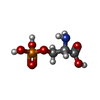+Search query
-Structure paper
| Title | Structures of G-bound metabotropic glutamate receptors mGlu2 and mGlu4. |
|---|---|
| Journal, issue, pages | Nature, Vol. 594, Issue 7864, Page 583-588, Year 2021 |
| Publish date | Jun 16, 2021 |
 Authors Authors | Shuling Lin / Shuo Han / Xiaoqing Cai / Qiuxiang Tan / Kexiu Zhou / Dejian Wang / Xinwei Wang / Juan Du / Cuiying Yi / Xiaojing Chu / Antao Dai / Yan Zhou / Yan Chen / Yu Zhou / Hong Liu / Jianfeng Liu / Dehua Yang / Ming-Wei Wang / Qiang Zhao / Beili Wu /  |
| PubMed Abstract | The metabotropic glutamate receptors (mGlus) have key roles in modulating cell excitability and synaptic transmission in response to glutamate (the main excitatory neurotransmitter in the central ...The metabotropic glutamate receptors (mGlus) have key roles in modulating cell excitability and synaptic transmission in response to glutamate (the main excitatory neurotransmitter in the central nervous system). It has previously been suggested that only one receptor subunit within an mGlu homodimer is responsible for coupling to G protein during receptor activation. However, the molecular mechanism that underlies the asymmetric signalling of mGlus remains unknown. Here we report two cryo-electron microscopy structures of human mGlu2 and mGlu4 bound to heterotrimeric G protein. The structures reveal a G-protein-binding site formed by three intracellular loops and helices III and IV that is distinct from the corresponding binding site in all of the other G-protein-coupled receptor (GPCR) structures. Furthermore, we observed an asymmetric dimer interface of the transmembrane domain of the receptor in the two mGlu-G structures. We confirmed that the asymmetric dimerization is crucial for receptor activation, which was supported by functional data; this dimerization may provide a molecular basis for the asymmetric signal transduction of mGlus. These findings offer insights into receptor signalling of class C GPCRs. |
 External links External links |  Nature / Nature /  PubMed:34135510 PubMed:34135510 |
| Methods | EM (single particle) |
| Resolution | 3.5 - 4.0 Å |
| Structure data | EMDB-31031, PDB-7e9g: EMDB-31032, PDB-7e9h: |
| Chemicals |  ChemComp-40F:  ChemComp-HZR:  ChemComp-SEP: |
| Source |
|
 Keywords Keywords |  MEMBRANE PROTEIN / mGlu2 / MEMBRANE PROTEIN / mGlu2 /  GPCR / GPCR /  Cryo-EM / Cryo-EM /  complex / mGlu4 complex / mGlu4 |
 Movie
Movie Controller
Controller Structure viewers
Structure viewers About Yorodumi Papers
About Yorodumi Papers









